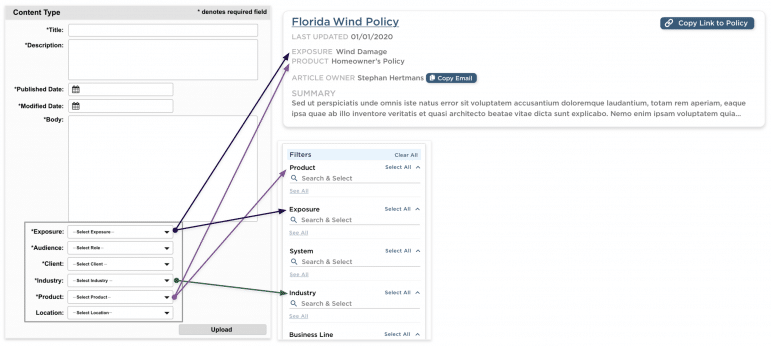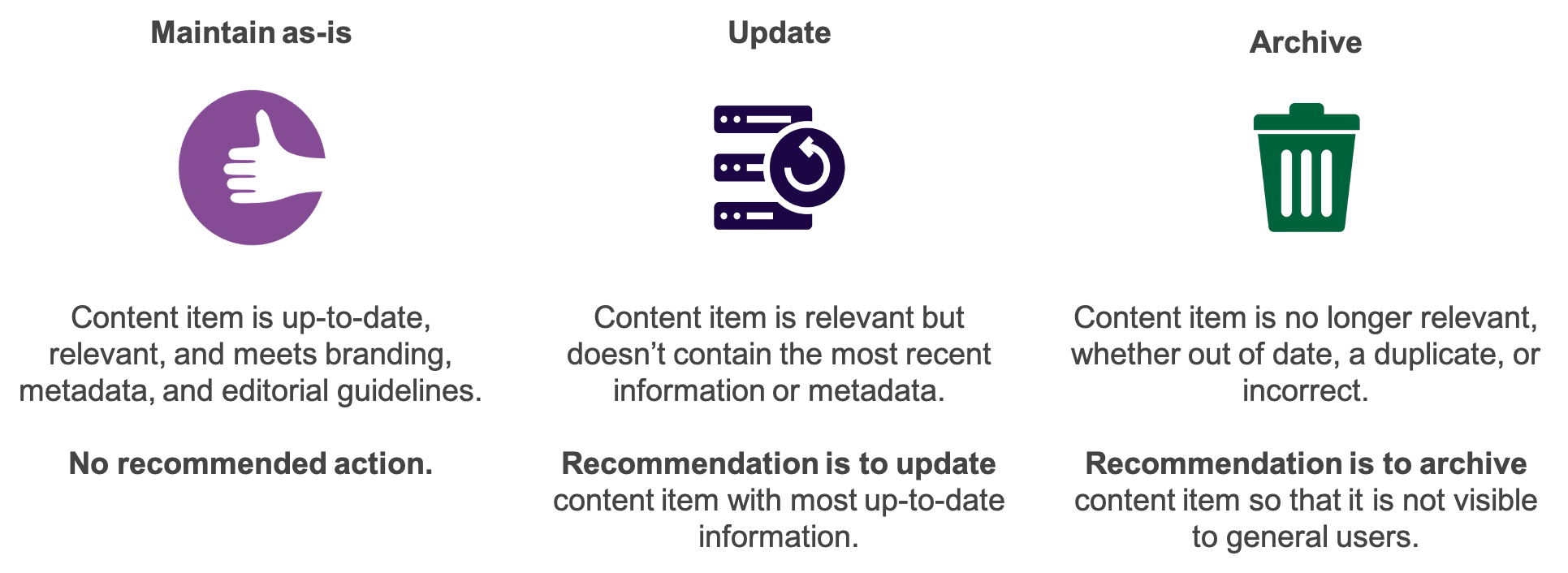
The Challenge
Staff at a US-based investment and insurance company were spending extraneous amounts of time finding information through the organization’s search experience. Users had been instructed to interact with search in specific ways (which filters to use, how to construct their queries, etc.), but the returned content and the available filters weren’t reflective of a recently changed department structure and returned content was consistently out-of-date or otherwise inaccessible.
In electing to upgrade their content storage system and allow for a more facile search experience, the organization recognized a need to undergo an enterprise content migration effort. To ensure outdated or unnecessary content was not migrated and human effort kept as low as possible, there was a need to leverage and apply KM best practices to both their taxonomy and content in parallel to the migration effort, allowing for a more intuitive search and information browsing experience.
Additionally, there was recognition that an enterprise taxonomy effort would support both immediate use cases, like improved findability, auto-tagging, and content management, and those that are more future-oriented, like auto-generated reports and customer support chatbots.

The Solution
Working closely with the organization’s SMEs and system migration team, EK developed an enterprise taxonomy to serve as the nexus between content template design, content governance strategies, and a semantic search experience. Specifically:
- EK redesigned and standardized content types to allow for the standardization of content in both quality and appearance. They benefit from defined taxonomies to both describe and tag the content.
- EK analyzed the organization’s content against 6 evaluation parameters to determine what content needed to be updated, archived, or maintained-as-is. This resulted in an actionable content inventory, clean-up, and migration plan for the organization to systematically clean-up their content before migration.
- A semantic search user interface was developed to guide the user experience and allow users to more quickly take action on the information they’re looking for, leveraging benefits from both content types (to standardize quality and appearance) and taxonomies (to standardize the language of describing content).
- The taxonomy standardizes the language around content and information and facilitates content tagging, describing the quality of content in search results, and takes a user-facing form as interactive search filters/refiners.
The taxonomy was enhanced via a corpus analysis and auto-tagging process that extracted concepts from the organization’s content and recommend taxonomy terms to be applied to the content.

The EK Difference
After meeting with users representative of all business units at the organization, EK designed an enterprise taxonomy, accompanying architecture model, and governance plan to ensure the taxonomy stays representative of the company’s information and content on an ongoing basis. This initial taxonomy work guided the design of both content type definition and the search experience, as users will interact with this taxonomy to both describe, tag, and search for content.
As the primary goal of this project is to provide the organization with a strategy to ensure successful system migration, governance plans for both the taxonomy and state of content are integral to the success of this migration effort. At EK, our hands-on experience spanning from design to implementation allowed us to coherently define touchpoints across the taxonomy development effort, search and content type design, and a recommended content governance plan, while acknowledging and working within system constraints. We were able to develop a highly customized solution that fit perfectly within the organization’s existing technical landscape, increasing the rate of interactivity and trust between users and the system as information was both more findable and more easily accessed.

The Results
EK’s KM-oriented taxonomy, content, auto-tagging, and search strategies yielded the following benefits:
- An 83% response rate for the taxonomy design activities ensured the taxonomy is reflective of the colloquial ways staff describe and talk about content;
- EK’s migration and cleanup plan identified that about 45% of their content (totaling 22,500 content items) were either outdated or obsolete and were identified as candidates for automatic archival without the need for additional manual efforts. This allowed the organization to shave the content that needed to be migrated by almost half and provided them with an actionable clean-up plan, including roles, responsibilities, and a timeline, that they could tackle before migrating content into the new system;
- The taxonomy was applied to content through a one-time auto-tagging process with an accuracy of 86-99% depending on the metadata field. This reduced the need for manual entry of metadata by auto-tagging 44% of all metadata fields and supporting search by making outputs of the taxonomy workstream immediately actionable, thus resulting in the increased findability of work resources; and
- The actionable content cleanup and governance strategy allowed for the identification of content items that were both ready for archiving and in need of review or updating, reducing the expected migration-related human effort by nearly 80%.


